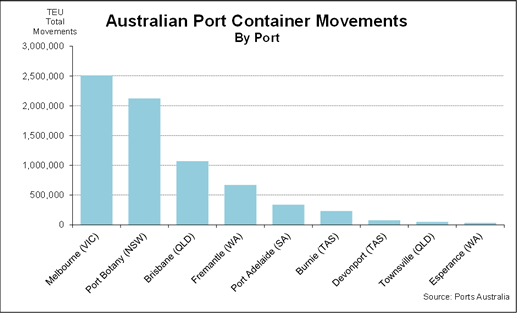Melbourne Industrial Market 2015
January 22nd 2015 | , Urban Property Australia
Competitive leasing environment maintains pressure on secondary assets as the trend of tenants upgrading their space when relocating, continues.
New Supply
Given that the Port of Melbourne processes between almost 40% of Australia’s port containers, with 2.5 million ports moving through the port annually, Melbourne remains a sought after location for most industrial users. In comparison, Sydney’s Port of Botany moves 2.2 million, and Brisbane 1.1 million containers. The strength of the port’s container traffic has made Melbourne the largest and fastest growing industrial market in the country with 46 million square metres of gross lettable area.
Victoria’s economy continues its shift from traditional manufacturing to other drivers such as retail trade and housing construction, industrial demand is also evolving.
Increasingly industrial construction activity is shaped by warehousing and logistics users driven by tenant demand from online retailers, food refrigeration facilities and transport services. In contrast, contractions in the manufacturing sector have seen many old manufacturing facilities being converted into residential developments.
Although new industrial supply continues to gather momentum, the level of new supply scheduled for completion in 2015 remains below the long term average. The upturn of industrial construction has largely resulted from an increase in pre-leases, particularly for major distribution centres and boosted owner occupier development, encouraged by the low interest rate levels.
Tenant Demand & Rents
The drive for efficiency and growing demand from population growth has led to a growing trend towards consolidation, which has resulted in a reduction in the numbers of facilities. While tenant demand has improved, the current soft business confidence levels have ensured that demand is still sporadic.
When tenants do relocate, preference remains for quality accommodation which has placed downward pressure on secondary rents. Prime industrial rental levels have largely remained steady over the year; however, increasing vacancy has resulted in a rise in the incentive levels. The West offering affordable options with good transport linkages continues to be the focus for the majority of tenants.
Secondary accommodation is likely to remain a short-term choice for many users uncertain of their business conditions, providing flexibility; particularly from the manufacturing sector.
Within the City Fringe despite sustained demand from occupiers, a lack of prime grade options are leading tenants to shift from the region. As a result of rezoning around Fishermans Bend, new development in the region is increasingly focussed on residential development, which is now offering higher and better use.
Land values for small sized sites in City Fringe have reached $1,000 per square metre, while land values for medium sized parcels have reached $850 per square metre.
Looking ahead, as the global (and local) economy continues to recover, the retail trade and transport & storage sectors are expected to drive the majority of industrial tenant demand and supply in 2015.
Sales Activity & Yields
Similar to Melbourne’s other property sectors, sales of industrial property reached record levels in 2014. Transactional levels of 2014 were boosted by a rise in investment portfolios that were offered to the market as investors sought to increase their exposure in the Australian industrial market. Domestic institutions were the most dominant purchasers, while offshore groups were also active, however most of this was led by North American and UK based investors.
The low interest rate environment has also attracted sitting tenants to become owner-occupiers. Booth Transport purchased 183 Fitzgerald Road, Laverton North for $14 million and ARB Corporation bought its formerly leased premises at 42-44 Garden Street, Kilsyth for $19 million.
While the investor demand has been particularly strong for prime grade facilities, high levels of capital availability coupled with limited core asset offerings has led some buyers to shift their focus to secondary assets. Competitive bidding has resulted in yield compression across both prime and secondary assets.
This strong investor appetite has compressed yields further; with prime yields tightening by 25 basis points over 2014 to now range between 7.70% and 8.25%, although assets with lease expiries of in excess of 10 years are likely to transact below 7.00%.




